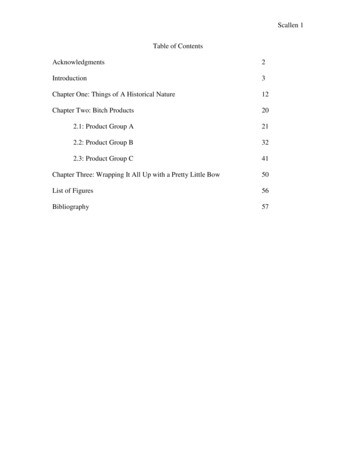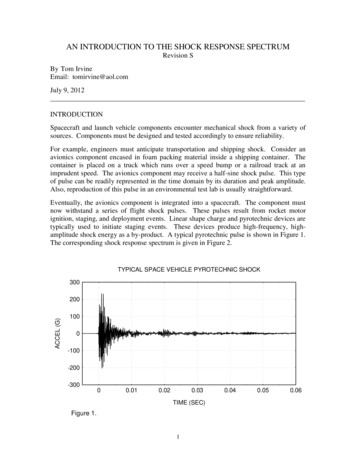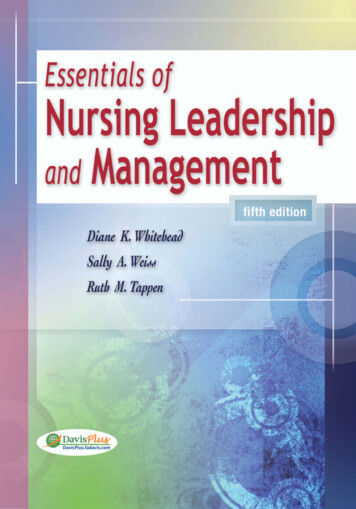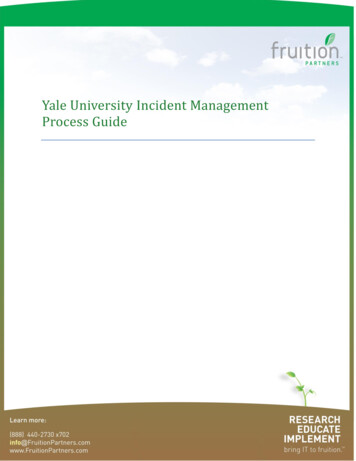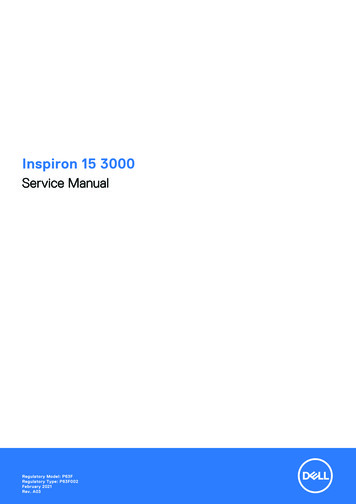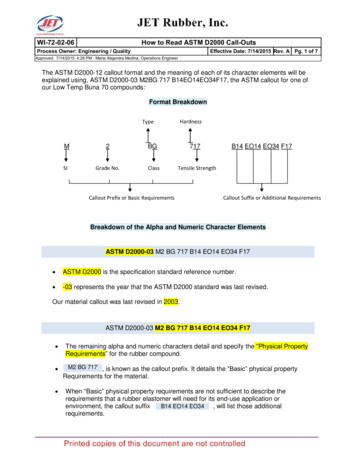
Transcription
WI-72-02-06How to Read ASTM D2000 Call-OutsEffective Date: 7/14/2015 Rev. A Pg. 1 of 7Process Owner: Engineering / QualityApproved: 7/14/2015 4:28 PM - Maria Alejandra Medina, Operations EngineerThe ASTM D2000-12 callout format and the meaning of each of its character elements will beexplained using, ASTM D2000-03 M2BG 717 B14EO14EO34F17, the ASTM callout for one ofour Low Temp Buna 70 compounds:Format BreakdownHardnessTypeM2BGSIGrade No.Class717B14 EO14 EO34 F17Tensile StrengthCallout Prefix or Basic RequirementsCallout Suffix or Additional RequirementsBreakdown of the Alpha and Numeric Character ElementsASTM D2000-03 M2 BG 717 B14 EO14 EO34 F17 ASTM D2000 is the specification standard reference number. -03 represents the year that the ASTM D2000 standard was last revised.Our material callout was last revised in 2003.ASTM D2000-03 M2 BG 717 B14 EO14 EO34 F17 The remaining alpha and numeric characters detail and specify the “Physical PropertyRequirements” for the rubber compound.M2 BG 717 , is known as the callout prefix. It details the “Basic” physical propertyRequirements for the material. When “Basic” physical property requirements are not sufficient to describe therequirements that a rubber elastomer will need for its end-use application orenvironment, the callout suffixB14 EO14 EO34, will list those additionalF17requirements.
WI-72-02-06How to Read ASTM D2000 Call-OutsRev. A Pg. 2 of 7ASTM D2000-03 M2 BG 717 B14 EO14 EO34 F17 The presence of the alpha-character M indicates that SI-Metric units for tensile (MPa)and temperature ( C) will be used. The absence of the alpha-character M indicates that English units for tensile (psi) andtemperature ( F) will be used.Our callout test data will use SI-Metric units.ASTM D2000-03 M2 BG 717 B14 EO14 EO34 F17 The next numeric-character specifies the “Grade” of the material and the scope of testrequirements that will apply to the specification. When the Grade is the numeric-character 1, only Callout Prefix or “Basic Requirements”apply. When the Grade is a numeric-character 2-9, “Callout “Suffix Requirements” or“Additional Requirements” apply.Our callout 2 indicates that additional tests are required. These requirements are detailedbelow.ASTM D2000-03 M2 BG 717 B14 EO14 EO34 F17 The next pair of alpha-characters, BG, designates material “Type and Class”. The alpha-character, B, represents the material “Type”. ASTM D2000-12 categorizes material Types based on Temperature Resistance. To determine Temperature Resistance for each Type, specimens are “heat aged” for 70hours to the test temperatures listed in Table 1.Table 1 Basic Requirements for EstablishingType by TemperatureTypeTest Temp. CA70B100C125D150E175F200G225H250J275K300* Taken from ASTM D2000-12 Standard
WI-72-02-06 How to Read ASTM D2000 Call-OutsRev. A Pg. 3 of 7After “heat aging”, test specimens must meet the following criteria:o Change in tensile strength: 30%o Change in elongation: -50% maxo Change in hardness: 15 pointsOur callout B indicates that heat aging testing will be conducted at 100 C. The next alpha-character, G, represents material “Class”. ASTM D2000 categorizes material “Class” based on Oil Resistance. Test specimens areimmersed in IRM 903 oil at temperatures listed in “Table 1” for 70 hours, to a maximumtesting temperature of 150 C - as IRM oil will degrade above this temperature. After “oil aging”, test specimens must meet the “Volume Swell” criteria listed in Table 2.Table 2 Basic Requirements for Establishing Class byVolume SwellClassVolume Swell, max, %ANo RequirementB140C120D100E80F60G40H30J20K10* Taken From ASTM D2000-12 StandardOur callout G indicates that the Test will be run at 100 C and have a Maximum VolumeSwell after oil aging is 40%. ASTM D2000-12 does not specify rubber compounds by the base materials names ofNeoprene, Buna-n, etc. Instead, ASTM D2000-12 groups these base materials by “Type and Class” (orTemperature and Oil Resistance) criterion. Table X1.1 references the type of polymers most often used for meeting Type and Classmaterial requirements.
WI-72-02-06How to Read ASTM D2000 Call-OutsRev. A Pg. 4 of 7Table X1.1 Polymers Most Often Used in Meeting Material RequirementsClassification System D2000SAE J200 Material DesignationType of Polymer Most Often Used(Type and Class)Natural Rubber, Reclaimed Rubber, SBR, Butyl, EPAAPolybutadiene, Polyisoprene,AKPolysulfidesEthylene Propylene (EPM), High-Temperature SBR andBAButyl CompoundsBCChloroprene Polymers (Neoprene)BEChloroprene Polymers (Neoprene)BFNBR Polymers (Nitrile)BGNBR Polymers (Nitrile), UrethanesBKNBRCAEthylene Propylene (EPM)CEChlorosulfonated Polyethylene (Hypalon)CHNBR Polymers (Nitrile), Epichlorohydrin Polymers (ECO)DAEthylene Propylene PolymersDECM, CSMDFPolyacrylic (Butyl-Acrylate Type)DHPolyacrylic Polymers, HNBREEAEMEHACMEKFZFCSilicones (High Strength)FESiliconesFKFluorinated SiliconesGESiliconesHKFluorinated Elastomers (Viton , Fluorel, etc.)KKPerfluoroelastomers* Taken From ASTM D2000-12 StandardASTM D2000-12 references Nitrile for our material callout BG.ASTM D2000-03 M2 BG 717 B14 EO14 EO34 F17 The numeric character, 7 indicates material hardness or durometer-measured in theShore A scale /- 5 points. To calculate hardness or durometer, this number is multiplied by 10.Our callout, 7, indicates a 65-75 durometer material.ASTM D2000-03 M2 BG 717 B14 EO14 EO34 F17 The numeric characters, 17, indicate material tensile strength-stated in MPa(Megapascals).Our callout 17 indicates a Tensile of 17 MPa.To convert MPa to psi multiply by 145.0377. Using this formula: 17 MPa 2466 psi.
WI-72-02-06How to Read ASTM D2000 Call-OutsRev. A Pg. 5 of 7For English unit callouts, these two digits would be multiplied by 100.Using this formula: 17 1700 psi.The Callout Prefix or “Basic Requirements” are finished for our callout.ASTM D2000-03 M2 BG 717 B14 EO14 EO34 F17B14 EO14 EO34 F17, our callout suffix, describes the additional requirements that ourrubber elastomer will require for its end-use application or environment. Callout suffixes are composed of a letter and two-digit number grouping. (Suffix letterfollowed by two suffix numbers). Suffix letters indicate a requirement that is listed in Table 3.Table 3 Meaning of Suffix LettersABCDEAEFEOFGJKMNPRZHeat ResistanceCompression SetOzone or Weather ResistanceCompression-Deflection ResistanceFluid Resistance (Aqueous)Fluid Resistance (Fuels)Fluid Resistance (Oils and Lubricants)Low Temperature ResistanceTear ResistanceAbrasion ResistanceAdhesionFlammability ResistanceImpact ResistanceStaining ResistanceResilienceSpecial Requirements (which shall be specified in detail)* Taken From ASTM D2000-12 StandardOur callout B indicates a Compression Set requirement.ASTM D2000-03 M2 BG 717 B14 EO14 EO34 F17 The first suffix “number”, in our grouping, specifies the test method and duration of thetest. “Table 5 ASTM Methods” in ASTM D2000-12 details all suffix callout compositions andthe respective requirements for each grade of polymer. *Only the table portions used toillustrate our callout are included in our illustration.
WI-72-02-06How to Read ASTM D2000 Call-OutsRev. A Pg. 6 of 7Table 5 ASTM MethodsBasic Requirements andFirst Suffix No.Requirement or Suffix LetterSuffix B, Compression Set,Standard Test SpecimenCut from a SlabBasic1234-D395,22 h,MethodB, solidD395,70 h,MethodB, solidD395,22 h,MethodB, plied5678D395,D395,D395,70 h,1000 h, 1000 h,Method Method MethodB, plied B, solid B, plied*Taken from ASTM D2000-12 StandardOur first suffix number 1 specifies that the test be run in accordance with Test D395 MethodB for 22 h, and that the material to be tested is a solid piece.ASTM D2000-03 M2 BG 717 B14 EO14 EO34 F17 The second suffix number in our grouping indicates the temperature at which the test isto be run. These temperatures are listed in Table 4.Table 4 Suffix Numbers to Indicate Temperature of TestApplicable SuffixRequirementsA, B, C, EA, EF,EO, G, KSecond SuffixNumberTest Temperature, bient Temp.(Outdoor -80* Taken From ASTM D2000-12 Standard
WI-72-02-06How to Read ASTM D2000 Call-OutsRev. A Pg. 7 of 7Our callout 4 indicates that suffix B polymers require a 100 C test temperature.All callout suffix elements test requirement “criteria” is listed in Table 6.Table 6 Basic and Supplementary (Suffix) Requirements for Classification of Elastomeric MaterialBG MaterialsGrade Grade Grade Grade Grade Grade Grade GradeSuffix Requirements12345678Compression Set, TestB14Methods D 395, Method B,255050252525max, %, 22 h at 100 C*Taken From ASTM D2000-12 StandardOur callout B14 has a 25 % max Compression Set requirement.Additional Requirements for EO14EO34F17, suffix element grouping:EO14RequirementsFluid ResistanceMethod D471, IRM 901 Oil, 70 h100 CChange in hardness: -5 to 10Change in tensile strength, max: -25%Change in ultimate elongation, max: -45%Change in Volume: -10 to 5 %EO34RequirementsFluid ResistanceMethod D471, IRM 903 Oil, 70 h100 CChange in hardness: -10 to 5Change in tensile strength, max: -45%Change in ultimate elongation, max: -45%Change in Volume: 0 to 25 %F17RequirementsLow-Temperature ResistanceD2137, Method C, 9.3.3, 3 min.-40 CNonbrittle after 3 min.Our callout lists no “Z” requirements.“Z” requirements are user defined and should always be clearly specified, and agreed uponby the customer, compounder and the molder.
ASTM D2000-12 does not specify rubber compounds by the base materials names of Neoprene, Buna-n, etc. Instead, ASTM D2000-12 groups these base materials by “Type and Class” (or Temperature and Oil Resistance) criterion. Table X1.1 references the type of polymers most often used for meeting Type and Class material requirements. WI-72-02-06 How to Read ASTM D2000 Call-Outs Rev. A Pg. 3 of 7 .File Size: 313KBPage Count: 7

